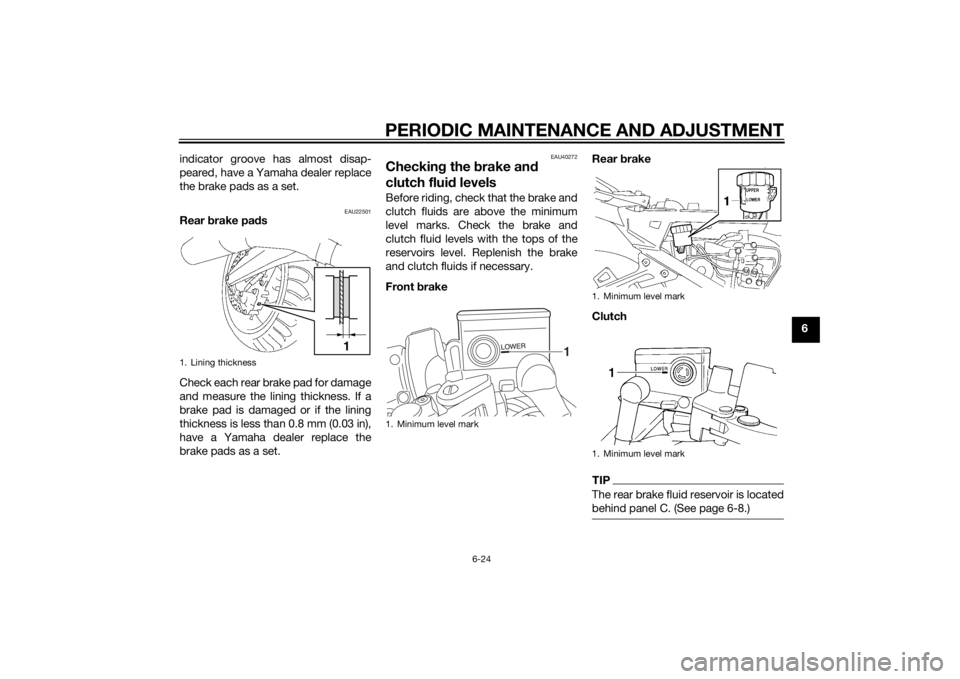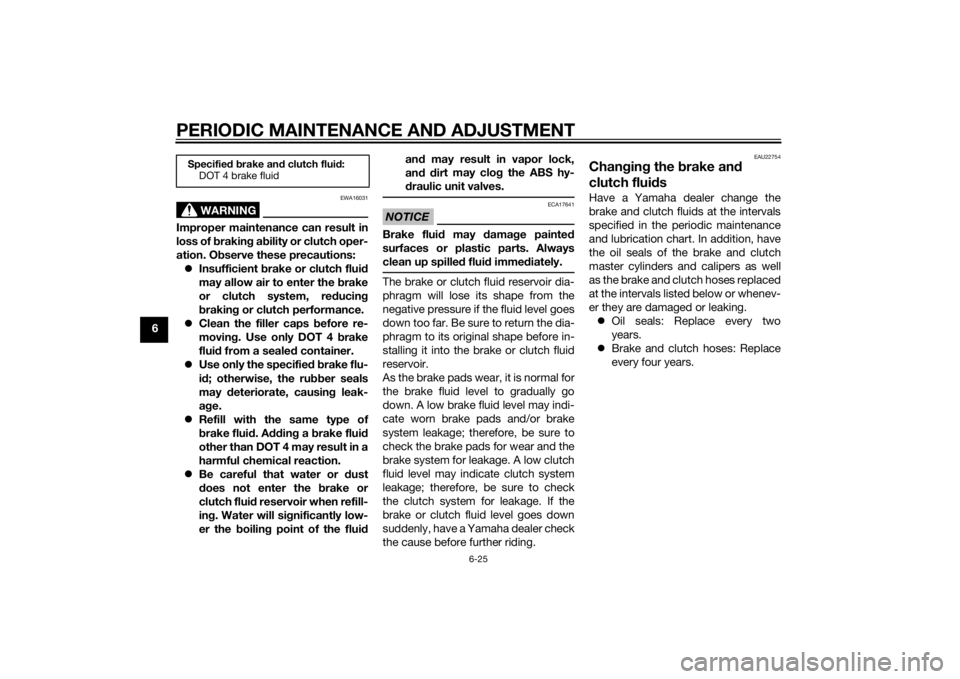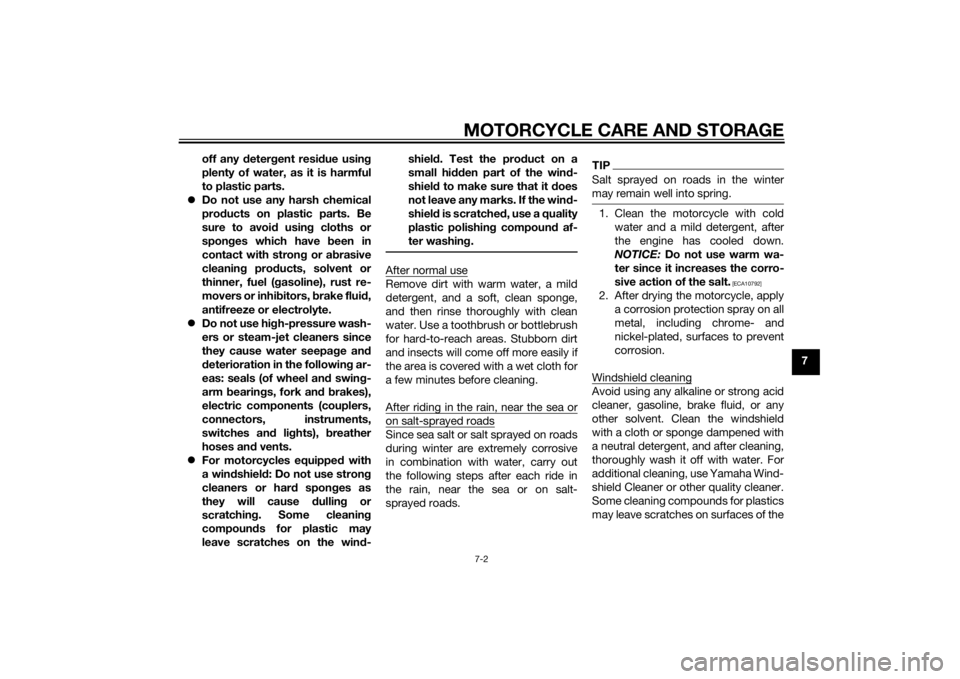2015 YAMAHA FJR1300A brake fluid
[x] Cancel search: brake fluidPage 91 of 120

PERIODIC MAINTENANCE AND ADJUSTMENT
6-24
6
indicator groove has almost disap-
peared, have a Yamaha dealer replace
the brake pads as a set.
EAU22501
Rear
brake pa ds
Check each rear brake pad for damage
and measure the lining thickness. If a
brake pad is damaged or if the lining
thickness is less than 0.8 mm (0.03 in),
have a Yamaha dealer replace the
brake pads as a set.
EAU40272
Checkin g the brake an d
clutch flui d levelsBefore riding, check that the brake and
clutch fluids are above the minimum
level marks. Check the brake and
clutch fluid levels with the tops of the
reservoirs level. Replenish the brake
and clutch fluids if necessary.
Front brake Rear
brake
Clutch
TIPThe rear brake fluid reservoir is located
behind panel C. (See page 6-8.)
1. Lining thickness
1
1. Minimum level mark
1
1. Minimum level mark
1. Minimum level mark
U1MCE2E0.book Page 24 Monday, June 16, 2014 8:57 AM
Page 92 of 120

PERIODIC MAINTENANCE AND ADJUSTMENT
6-25
6
WARNING
EWA16031
Improper maintenance can result in
loss of braking a bility or clutch oper-
ation. O bserve these precautions:
Insufficient brake or clutch flui d
may allow air to enter the brake
or clutch system, re ducing
b rakin g or clutch performance.
Clean the filler caps before re-
moving . Use only DOT 4 b rake
flui d from a seale d container.
Use only the specified b rake flu-
i d ; otherwise, the ru bber seals
may deteriorate, causin g leak-
a g e.
Refill with the same type of
brake flui d. A ddin g a brake flui d
other than DOT 4 may result in a
harmful chemical reaction.
Be careful that water or d ust
d oes not enter the brake or
clutch flui d reservoir when refill-
in g. Water will si gnificantly low-
er the boilin g point of the flui dan
d may result in vapor lock,
an d d ir t may clo
g th
e ABS hy-
d raulic unit valves.
NOTICE
ECA17641
Brake fluid may damag e painted
surfaces or plastic parts. Always
clean up spille d flui d imme diately.The brake or clutch fluid reservoir dia-
phragm will lose its shape from the
negative pressure if the fluid level goes
down too far. Be sure to return the dia-
phragm to its original shape before in-
stalling it into the brake or clutch fluid
reservoir.
As the brake pads wear, it is normal for
the brake fluid level to gradually go
down. A low brake fluid level may indi-
cate worn brake pads and/or brake
system leakage; therefore, be sure to
check the brake pads for wear and the
brake system for leakage. A low clutch
fluid level may indicate clutch system
leakage; therefore, be sure to check
the clutch system for leakage. If the
brake or clutch fluid level goes down
suddenly, have a Yamaha dealer check
the cause before further riding.
EAU22754
Chan gin g the brake an d
clutch flui dsHave a Yamaha dealer change the
brake and clutch fluids at the intervals
specified in the periodic maintenance
and lubrication chart. In addition, have
the oil seals of the brake and clutch
master cylinders and calipers as well
as the brake and clutch hoses replaced
at the intervals listed below or whenev-
er they are damaged or leaking.
Oil seals: Replace every two
years.
Brake and clutch hoses: Replace
every four years.
Specifie d b rake an d clutch flui d:
DOT 4 brake fluid
U1MCE2E0.book Page 25 Monday, June 16, 2014 8:57 AM
Page 107 of 120

MOTORCYCLE CARE AND STORAGE7-2
7
off any
deter gent resi due usin g
plenty of water, as it is harmful
to plastic parts.
Do not use any harsh chemical
prod ucts on plastic parts. Be
sure to avoi d usin g cloths or
spon ges which have b een in
contact with stron g or a brasive
cleanin g prod ucts, solvent or
thinner, fuel ( gasoline), rust re-
movers or inhi bitors, brake flui d,
antifreeze or electrolyte.
Do not use hi gh-pressure wash-
ers or steam-jet cleaners since
they cause water seepag e and
d eterioration in the followin g ar-
eas: seals (of wheel an d swin g-
arm bearin gs, fork an d b rakes),
electric components (couplers,
connectors, instruments,
switches an d li ghts), breather
hoses an d vents.
For motorcycles equippe d with
a win dshiel d: Do not use stron g
cleaners or har d spon ges as
they will cause dullin g or
sc r
atchin g. Some cleanin g
compoun ds for plastic may
leave scratches on the win d- shiel
d. Test the pro duct on a
small hi dden part of the win d-
shiel d to make sure that it does
not leave any marks. If the win d-
shiel d is scratche d, use a quality
plastic polishin g compoun d af-
ter washing .
After normal useRemove dirt with warm water, a mild
detergent, and a soft, clean sponge,
and then rinse thoroughly with clean
water. Use a toothbrush or bottlebrush
for hard-to-reach areas. Stubborn dirt
and insects will come off more easily if
the area is covered with a wet cloth for
a few minutes before cleaning.
After riding in the rain, near the sea oron salt-sprayed roadsSince sea salt or salt sprayed on roads
during winter are extremely corrosive
in combination with water, carry out
the following steps after each ride in
the rain, near the sea or on salt-
sprayed roads.
TIPSalt sprayed on roads in the winter
may remain well into spring.1. Clean the motorcycle with cold
water and a mild detergent, after
the engine has cooled down.
NOTICE: Do not use warm wa-
ter since it increases the corro-
sive action of the salt.
[ECA10792]
2. After drying the motorcycle, apply a corrosion protection spray on all
metal, including chrome- and
nickel-plated, surfaces to prevent
corrosion.
Windshield cleaningAvoid using any alkaline or strong acid
cleaner, gasoline, brake fluid, or any
other solvent. Clean the windshield
with a cloth or sponge dampened with
a neutral detergent, and after cleaning,
thoroughly wash it off with water. For
additional cleaning, use Yamaha Wind-
shield Cleaner or other quality cleaner.
Some cleaning compounds for plastics
may leave scratches on surfaces of the
U1MCE2E0.book Page 2 Monday, June 16, 2014 8:57 AM
Page 112 of 120

SPECIFICATIONS
8-2
8
Secondary reduction ratio:2.698 (35/37 x 21/27 x 33/9)
Transmission type: Constant mesh 5-speed
Operation:
Left foot operation
Gear ratio: 1st:
2.529 (43/17)
2nd: 1.773 (39/22)
3rd: 1.348 (31/23)
4th:
1.077 (28/26)
5th: 0.929 (26/28)Chassis:Frame type:
Diamond
Caster angle: 26.00 °
Trail: 109 mm (4.3 in)Front tire:Type:Tubeless
Size: 120/70 ZR17M/C (58W)
Manufacturer/model:
BRIDGESTONE/BT023F F
Manufacturer/model: METZELER/Roadtec Z8
Rear tire:Type:Tubeless
Size:
180/55 ZR17M/C (73W)
Manufacturer/model: BRIDGESTONE/BT023R F
Manufacturer/model: METZELER/Roadtec Z8 CLoa din g:Maximum load:
215 kg (474 lb)
(Total weight of rider, passenger, cargo
and accessories)Tire air pressure (measure d on col d
tires):Loading condition:
0–90 kg (0–198 lb)
Front:
250 kPa (2.50 kgf/cm², 36 psi)
Rear: 290 kPa (2.90 kgf/cm², 42 psi)
Loading condition: 90–215 kg (198–474 lb)
Front:
250 kPa (2.50 kgf/cm², 36 psi)
Rear: 290 kPa (2.90 kgf/cm², 42 psi)
High-speed riding: Front: 250 kPa (2.50 kgf/cm², 36 psi)
Rear: 290 kPa (2.90 kgf/cm², 42 psi)
Front wheel:Wheel type:Cast wheel
Rim size:
17M/C x MT3.50Rear wheel:Wheel type:Cast wheel
Rim size:
17M/C x MT5.50Unifie d b rake system:Operation:
Activated by rear brakeFront brake:Type:
Dual disc brake
Operation: Right hand operation
Specified brake fluid:
DOT 4Rear brake:Type:
Single disc brake
Operation:
Right foot operation
Specified brake fluid: DOT 4Front suspension:Type:
Telescopic fork
Spring/shock absorber type: Coil spring/oil damper
Wheel travel: 135 mm (5.3 in)
U1MCE2E0.book Page 2 Monday, June 16, 2014 8:57 AM
Page 116 of 120

10-1
10
INDEXAABS ....................................................... 3-27
ABS warning light ................................... 3-5
Accessory box ...................................... 3-36
Air filter element, cleaning .................... 6-17
Auxiliary DC jack ................................... 3-45
Auxiliary light......................................... 6-34BBattery .................................................. 6-30
Brake and clutch fluid levels, checking ............................................. 6-24
Brake and clutch fluids, changing ........ 6-25
Brake and clutch levers, checking and lubricating ........................................... 6-27
Brake and shift pedals, checking and
lubricating ........................................... 6-26
Brake lever ............................................ 3-26
Brake lever free play, checking............. 6-22
Brake light switches.............................. 6-23
Brake pedal........................................... 3-26CCables, checking and lubricating ......... 6-26
Care ........................................................ 7-1
Catalytic converters .............................. 3-31
Centerstand and sidestand, checking and lubricating .................................... 6-28
Clutch lever ................................. 3-25, 6-22
Coolant ................................................. 6-16
Cowling vents, opening and closing ..... 3-37
Cruise control indicator lights ................. 3-4
Cruise control switches ........................ 3-24
Cruise control system ............................. 3-6DDimmer/Pass switch ............................. 3-24 D-mode (drive mode) ........................... 3-23
EEngine break-in ...................................... 5-3
Engine idling speed, checking ............. 6-18
Engine oil and oil filter
cartridge ........... 6-12
Engine serial number .............................. 9-1
Engine trouble warning light ................... 3-5FFinal gear oil ......................................... 6-14
Front and rear brake pads, checking ... 6-23
Front fork, adjusting ............................. 3-39
Front fork, checking ............................. 6-29
Front turn signal light............................ 6-34
Fuel ....................................................... 3-30
Fuel consumption, tips for reducing ...... 5-3
Fuel tank breather/overflow hose ......... 3-31
Fuel tank cap ........................................ 3-29
Fuses, replacing ................................... 6-32HHandlebar position, adjusting .............. 3-37
Handlebar switches .............................. 3-23
Hazard switch....................................... 3-24
Headlight beams, adjusting.................. 3-37
Headlight bulb ...................................... 6-33
High beam indicator light ....................... 3-4
Horn switch .......................................... 3-24IIdentification numbers ............................ 9-1
Ignition circuit cut-off system ............... 3-43
Immobilizer system ................................ 3-1
Immobilizer system indicator light .......... 3-6
Indicator lights and warning lights ......... 3-4LLicense plate light bulb, replacing........ 6-35
MMain switch/steering lock .......................3-2
Maintenance and lubrication, periodic....6-4
Maintenance, emission control
system ..................................................6-3
Matte color, caution ................................7-1
Menu switch..........................................3-24
Model label .............................................9-1
Multi-function meter unit .......................3-10NNeutral indicator light ..............................3-4OOil level warning light ..............................3-4PPanels, removing and installing ..............6-8
Parking ....................................................5-4
Part locations ..........................................2-1RRear suspension, lubricating ................6-28
Rear view mirrors ..................................3-39
Rider seat height, adjusting ..................3-33SSafety information ...................................1-1
Seats .....................................................3-32
Select switch.........................................3-25
Shifting ....................................................5-2
Shift pedal .............................................3-26
Shock absorber assembly, adjusting ....3-41
Sidestand ..............................................3-42
Spark plugs, checking ..........................6-11
Specifications .........................................8-1
Start/Engine stop switch .......................3-24
Starting the engine ..................................5-1
Steering, checking ................................6-30
U1MCE2E0.book Page 1 Monday, June 16, 2014 8:57 AM